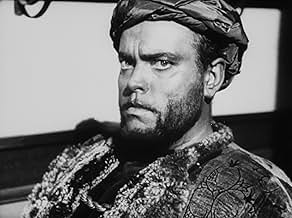NOTE IMDb
7,5/10
9,7 k
MA NOTE
Le général maure Othello est manipulé et pense que sa nouvelle épouse Desdémone a eu une liaison avec son lieutenant Michael Cassio alors qu'en réalité, tout cela fait partie du plan de Iago... Tout lireLe général maure Othello est manipulé et pense que sa nouvelle épouse Desdémone a eu une liaison avec son lieutenant Michael Cassio alors qu'en réalité, tout cela fait partie du plan de Iago.Le général maure Othello est manipulé et pense que sa nouvelle épouse Desdémone a eu une liaison avec son lieutenant Michael Cassio alors qu'en réalité, tout cela fait partie du plan de Iago.
- Récompenses
- 1 victoire et 1 nomination au total
Abdullah Ben Mohamet
- Pageboy
- (non crédité)
Joseph Cotten
- Senator
- (non crédité)
Jean Davis
- Montano
- (non crédité)
Joan Fontaine
- Page
- (non crédité)
Robert Rietty
- Lodovico
- (voix)
- (non crédité)
Gudrun Ure
- Desdemona
- (voix)
- (non crédité)
Histoire
Le saviez-vous
- AnecdotesThe movie was shot over three years and production was stopped twice, mainly because Welles ran out of money. He then starred in the films "Le Troisième Homme (1949)" and "Échec à Borgia (1949)." He took his payment from those films and used them as money for "Othello".
- Versions alternativesThis film by Orson Welles, was 'restored' by a group in Chicago in 1991/2. The film was transferred to, and enhanced in video, (D1 format) retaining it as black and white. The audio was completely rebuilt, including the score, in Stereo Surround. All dialogue, however was original. This was a problem as some of the dialogue was distorted and unintelligible. John Fogelson, editor, was a major supervisor of the project. Ed Golya, Lorita DeLacerna, and Steve Wilke, were digital editors. And Ed Golya remixed the soundtrack. The process took 9 months. It was purchased for distribution by Castle Hill, and taken to New York where it went through another transformation before release. The restoration engineer in New York, Paul Michael, restored the audio that was supplied on 35mm optical negatives. He was able to remove the distortion, optical pops and surface noise that is inherent with Optical negatives. The restored audio was then sent to Sound One for the final mix. Unintelligible dialogue was replaced with 'sound-alikes'. This decision was made for the entertainment value of the film. The original mono music was then reintroduced into the final product. Basically, the film was retransferred, and the rebuilt sound effects tracks were added. This was done at Sound One, in NYC.. The credits were adjusted to place Lee Dickter (sp?) as Re-recording Mixer, and Ed Golya as Sound Effects Editor.
- ConnexionsEdited into Histoire(s) du cinéma: La monnaie de l'absolu (1999)
Commentaire à la une
Commenting on Shakespeare films is rather like admiring Easter Eggs.
First the inside: this was never a great play, relative to Shakespeare's other works. His great plays are about ideas, with characters as vectors to prod and activate them. This play is merely about characters, which makes it attractive to actors. That's certainly why Welles selected it.
Welles is the Sinatra of dramatic reading, with phrasing mastered in his radio days. All else is acceptable (at least to my tastes) so far as the play goes.
Now the shell, and here is what makes this film one of the most important. When Welles moved into film, he did so as an architect. He understood that great film constructs a space that includes the audience. So he worked with the most direct tools, buildings themselves. These sets are remarkable. I cannot imagine how he found them, how he could have seen the possibilities.
Selection aside, how he uses the spaces! View this film at least once in silence. I rate Welles as one of the 20th century's great architects and predict that this film will be mined when we get around to really creating cyberbuilding.
First the inside: this was never a great play, relative to Shakespeare's other works. His great plays are about ideas, with characters as vectors to prod and activate them. This play is merely about characters, which makes it attractive to actors. That's certainly why Welles selected it.
Welles is the Sinatra of dramatic reading, with phrasing mastered in his radio days. All else is acceptable (at least to my tastes) so far as the play goes.
Now the shell, and here is what makes this film one of the most important. When Welles moved into film, he did so as an architect. He understood that great film constructs a space that includes the audience. So he worked with the most direct tools, buildings themselves. These sets are remarkable. I cannot imagine how he found them, how he could have seen the possibilities.
Selection aside, how he uses the spaces! View this film at least once in silence. I rate Welles as one of the 20th century's great architects and predict that this film will be mined when we get around to really creating cyberbuilding.
Meilleurs choix
Connectez-vous pour évaluer et suivre la liste de favoris afin de recevoir des recommandations personnalisées
- How long is Othello?Alimenté par Alexa
Détails
- Date de sortie
- Pays d’origine
- Sites officiels
- Langues
- Aussi connu sous le nom de
- Orson Welles' Othello
- Lieux de tournage
- Castle, El Jadida, Maroc(cistern interior)
- Sociétés de production
- Voir plus de crédits d'entreprise sur IMDbPro
Box-office
- Montant brut aux États-Unis et au Canada
- 28 980 $US
- Week-end de sortie aux États-Unis et au Canada
- 6 010 $US
- 27 avr. 2014
- Montant brut mondial
- 28 980 $US
- Durée1 heure 30 minutes
- Couleur
- Rapport de forme
- 1.37 : 1
Contribuer à cette page
Suggérer une modification ou ajouter du contenu manquant


































